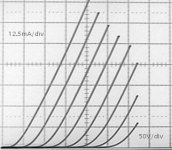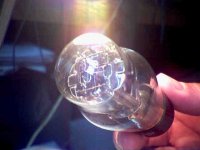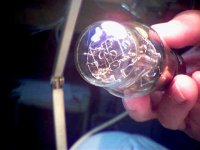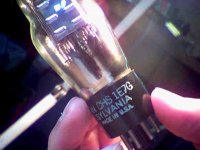It's the non-linearity of tubes that has made them so beloved of so many electric guitarists and audio enthusiasts. It's that lovely non-linearity that makes up for all those disadvantages tubes have!
I understand your excitement, but please keep flies and meatballs separately. Lovely non-linearities are good for effect boxes, while "audio enthusiasts" love them for something completely different: for absence of "non-lovely non-linearity". I (as one of enthusiasts for whom you are trying to speak) would prefer absence of that "lovely non-linearity" as well, but it is impossible, unfortunately.
Re: Gordy
The 306A has got a 5 pin base and a plate cap. (The mystery tube has an Octal base and no cap.) The 306A does have one crucial aspect in common with the "mystery" tube. But the 306A is 5 times bigger and not too likely available for $3. The 306A datasheet curves do look quite good and it could well be a super linear triode. I don't have one to test here though. The mystery tube was a junk box dust collector, fairly obscure, I just tried it on the tracer one day. Totally amazed. I'm sure there are a bunch of other undiscovered wonder tubes out there yet.
Oops, please excuse me for being so far out - I'll put it down to tiredness... well, it is coming up to 3:20 in the morning here and I really should have been asleep long ago! Zzzzzzz...
I hope others take a guess at the source of the curves that you attached in post #28
It's the only way to maintain an illogical position in the face of contradictory evidence...
It's a useful way to deal with an ill-considered 'test' (that relies upon a flawed premise and hence has no real credibility) that is purportedly masquerading as a useable procedure.
Never mind.
Gordy off to bed...
I've seen some journal papers on microlithic vacuum tubes. There is even a small book out. All of the ones I saw were using point field emitters, which would be too unreliable for ICs. But that was 10 years ago. New developments like carbon nanofibers or tunneling emitters may have changed the game. The real money behind it is probably the flat screen video monitor research. Maybe we will be using flat screen monitors someday to make amplifiers. Interesting audio/visual effects too.
Edit: OOPs, Sorry, I made a goof on the mystery tube plot scaling data. It's plotted with 2 Volts per grid step, not 1 V. Mu of 10 then obviously.
Edit: OOPs, Sorry, I made a goof on the mystery tube plot scaling data. It's plotted with 2 Volts per grid step, not 1 V. Mu of 10 then obviously.
Last edited:
Straight curves or not if it is a triode it is not linear. Pick an operating point draw a load line. The straights (curves) are progressively closer together on the right side of the operating point and vice versa. The decreasing spacing of the curves means decreasing mu from the left side of the graph to right this is classic triode 2nd harmonic distortion.That really is a very impressive set of straights (can't bring myself to call them curves!).
BTW add a pinch of partial bypass to the cathode resistor and you can straighten any triode curve. Remove the bypass capacitor from a capacitor from a triode, if you put it on a curve tracer and the curves look like those of a pentode. Vary the value of the cathode resistor the rate of curvature will also change. I think that it is FM.
Also take a look at the old texts of pentodes turned triode. Convex curves of pentodes, concave curves of triode strapped pentodes and straight curves of ultralinear.
I would not be surprised if there was some of this Magic going on it the curves posted in this thread.
DT
All just for fun!
Many people believe that linearity which is achieved via local feedback (which would be the case for a perfectly linear triode) sounds different from equal linearity achieved through global feedback. Perhaps because local feedback tends to have a higher stability margin, or better transient reproduction due to the dominant pole being above the audio range. Don't ask me, I'm just suggesting that the two might not sound the same.You all do realize that a perfectly linear triode would not sound any different than a good quality high-gain transistor amp with a ton of negative feedback, which is virtually perfectly linear?
Yes we know, but above about 2mA those curves really are equally spaced! So just stay out of the sub-2mA region.Straight curves or not if it is a triode it is not linear. The decreasing spacing of the curves means decreasing mu from the left side of the graph to right
"Thank goodness for nonlinear tubes!"
Always delighted to see your tracer shots !
Member
Joined 2009
Paid Member
Imagine a dual pentode on an octal base back in the battery tube days!
Pretty neat
- Status
- This old topic is closed. If you want to reopen this topic, contact a moderator using the "Report Post" button.
- Home
- Amplifiers
- Tubes / Valves
- Could this be a perfectly linear triode?
 Let's not turn this into another tube vs SS debate. OT posts deleted.
Let's not turn this into another tube vs SS debate. OT posts deleted.


